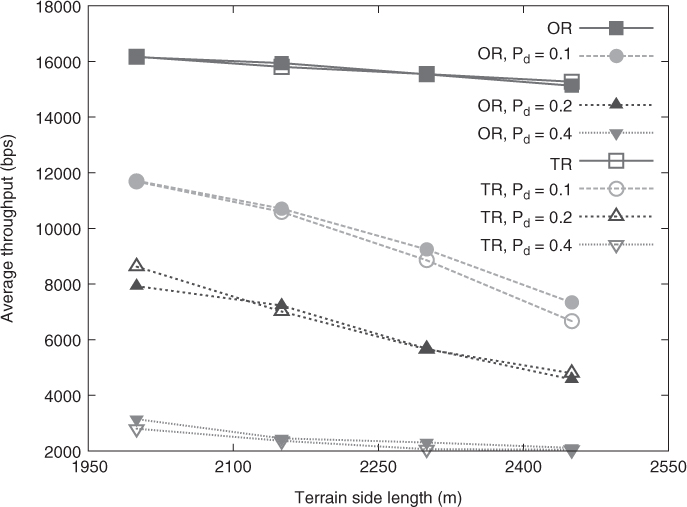9.3 Resilience to Packet-Dropping Attack
A packet-dropping attack is a common attack in multihop wireless networks, where malicious nodes simply drop all the packets routed through themselves. It is intuitive that, because of its multipath nature, opportunistic routing should be more resilient to the packet dropping attack than the traditional single path routing. We conduct a simulation to validate this intuition. The simulation settings are the same as the simulation in Section 9.1.2 except that the malicious attackers do lie on the link quality but drop packets. For each run, a certain proportion (Pm) of nodes in the network are set as malicious nodes, which drop all the packets routing through them. We assume the source and destination nodes are not malicious. The simulation result is shown in Figure 9.4. Each point on the figure is the average value of five random runs. It shows that generally opportunistic routing is more resilient than traditional single-path routing when faced with a packet-dropping attack. The throughput deceases when more nodes in the network are malicious.
Figure 9.4 Average end-to-end throughput of opportunistic routing and traditional routing under packet dropping attack.

However, in some case, for example, when terrain side length is 2000 m and Pm = 0.2, single-path routing can deliver more packets. The reason behind it can be as follows. When the network area is not large, nodes travel fewer hops from the source to the destination. Then when the malicious nodes are few, the probability at which a malicious node is on the path of single-path traditional routing is lower than that of opportunistic routing, because opportunistic routing involves more nodes. Therefore, in this situation, the multipath nature of opportunistic routing may adversely harm opportunistic routing. Consider a scenario in which a single-path routing only involves one intermediate node, whereas opportunistic routing may involve two intermediate nodes, one of which is shared with the single path routing. When the shared node is malicious, neither of the two routing protocols can deliver packets. When the other node is malicious, however, opportunistic routing may loose some packets due to malicious dropping but traditional routing can deliver all the packets. Then statistically single-path traditional routing can achieve higher throughput than opportunistic routing. It is worth investigating further the mathematical foundations of the performance degradation of opportunistic routing in the presence of a packet-dropping attack, and identifying the situations when opportunistic routing performs better or worse than traditional single-path routing.
